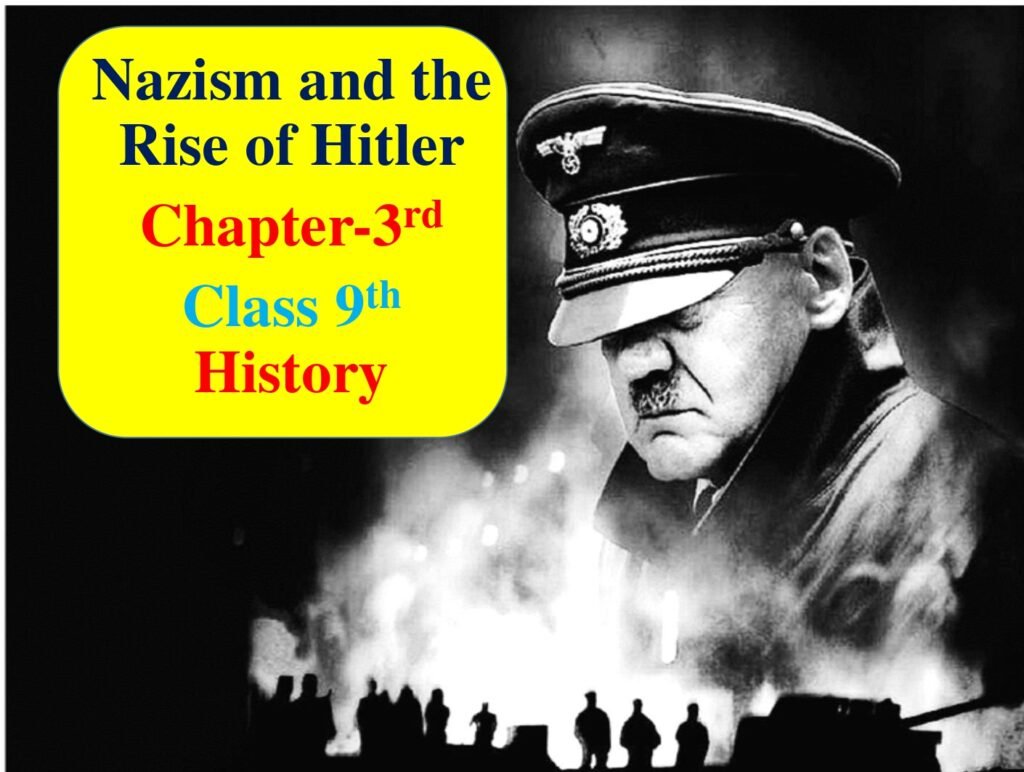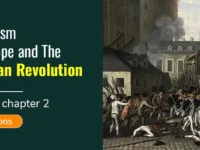🔹 1. Introduction
- Nazism was a political ideology in Germany led by Adolf Hitler.
- It emerged after World War I, during economic crisis and political instability.
- Promoted extreme nationalism, racism, and anti-Semitism.
- Hitler became chancellor in 1933 and established a totalitarian state.
Summary
Nazism rose in Germany after World War I due to economic hardship, political instability, and resentment over the Treaty of Versailles. Hitler and the Nazi Party promoted nationalism, anti-Semitism, and the idea of Aryan supremacy. They controlled the government, banned opposition, and spread propaganda. Nazi policies led to persecution of Jews, militarization, and World War II. Hitler’s rise showed how economic crises and propaganda can enable dictators.
🔹 2. Causes of Nazism
- Treaty of Versailles – Germany blamed for WWI, lost territories, and had to pay reparations.
- Economic Crisis – Great Depression worsened unemployment and poverty.
- Political Instability – Weak Weimar Republic could not solve problems.
- Nationalism and Racism – Hitler promoted Aryan superiority and anti-Semitism.
- Propaganda and Mass Support – Nazi Party used rallies, speeches, and media to gain followers.
🔹 3. Rise of Hitler
- Hitler joined Nazi Party in 1920.
- Failed Munich Putsch (1923) → imprisoned, wrote Mein Kampf.
- Nazis gained support during Great Depression.
- 1933: Hitler became Chancellor → totalitarian rule.
- SS, Gestapo created to control opposition.
🔹 4. Policies and Impact
- Economic policies: Reduced unemployment, public works, militarization.
- Social policies: Anti-Semitic laws, persecution of Jews (Holocaust).
- Political policies: Banned opposition, propaganda, indoctrination of youth.
- Impact: Totalitarian state, WWII, death of millions, lessons on dangers of dictatorship.
🔹 5. Key Terms
- Weimar Republic: German government after WWI.
- Anti-Semitism: Hatred against Jews.
- Aryan supremacy: Belief in racial superiority of Germans.
- Gestapo: Secret police.
- SS: Elite paramilitary organization.
✅ Multiple Choice Questions (MCQs)
- Who led the Nazi Party?
a) Mussolini b) Hitler c) Stalin d) Franco - When did Hitler become Chancellor of Germany?
a) 1920 b) 1923 c) 1933 d) 1939 - Treaty of Versailles blamed Germany for:
a) WWII b) WWI c) Cold War d) Napoleonic Wars - What is anti-Semitism?
a) Hatred of Jews b) Support for Jews c) Political theory d) Economic policy - What did Hitler write in prison?
a) Das Kapital b) Mein Kampf c) The Republic d) Social Contract - Which organization was Hitler’s secret police?
a) Gestapo b) SS c) SA d) Wehrmacht - What was the Munich Putsch?
a) Economic plan b) Failed coup by Nazis c) Treaty d) Youth program - Which crisis helped Hitler rise to power?
a) Industrial Revolution b) Great Depression c) Franco-Prussian War d) WWI - Aryan supremacy refers to:
a) German racial superiority b) French culture c) Italian heritage d) British monarchy - Nazis banned:
a) Opposition parties b) Propaganda c) Hitler d) Militarization - SS was:
a) Education group b) Elite paramilitary c) Political party d) Industrial union - Which country did Nazis blame for WWI?
a) France b) Russia c) Germany d) UK - Hitler’s ideology promoted:
a) Democracy b) Fascism and dictatorship c) Socialism d) Communism - Holocaust was:
a) Economic plan b) Persecution and murder of Jews c) School reform d) Treaty - Hitler gained support using:
a) Newspapers, rallies, speeches b) Monarchy c) Religion d) Treaties
✅ Assertion and Reason Questions
Q1.
- Assertion (A): Hitler became Chancellor in 1933.
- Reason (R): Nazis gained popularity due to economic hardship.
a) Both A and R true, R correct explanation of A
b) Both A and R true, R not correct explanation of A
c) A true, R false
d) A false, R true
Q2.
- Assertion (A): The Treaty of Versailles angered Germans.
- Reason (R): It imposed reparations and territorial losses on Germany.
a) Both A and R true, R correct explanation of A
b) Both A and R true, R not correct explanation of A
c) A true, R false
d) A false, R true
Q3.
- Assertion (A): Anti-Semitic laws were part of Nazi policies.
- Reason (R): Nazis believed Jews were inferior and a threat to Germany.
a) Both A and R true, R correct explanation of A
b) Both A and R true, R not correct explanation of A
c) A true, R false
d) A false, R true
Q4.
- Assertion (A): Nazis used propaganda effectively.
- Reason (R): Mass rallies, speeches, and media influenced public opinion.
a) Both A and R true, R correct explanation of A
b) Both A and R true, R not correct explanation of A
c) A true, R false
d) A false, R true
Q5.
- Assertion (A): Hitler promoted Aryan supremacy.
- Reason (R): Nazis believed German race was superior and should dominate.
a) Both A and R true, R correct explanation of A
b) Both A and R true, R not correct explanation of A
c) A true, R false
d) A false, R true
🧠 Case-Based Study Questions
Case Study 1:
Germany faced unemployment, poverty, and resentment after WWI. Hitler promised strong leadership.
- What economic problems did Germany face?
- Who promised strong leadership?
- Why were Germans angry?
- How did Nazis gain popularity?
- When did Hitler become Chancellor?
Case Study 2:
Treaty of Versailles imposed reparations and territorial losses. Germans resented this treaty.
- What did the Treaty of Versailles impose?
- How did Germans feel about it?
- Did it contribute to Hitler’s rise?
- Name one territorial loss of Germany.
- What were reparations?
Case Study 3:
Nazis promoted Aryan supremacy and persecuted Jews through anti-Semitic laws.
- What is Aryan supremacy?
- Which group was persecuted?
- What type of laws were passed?
- Why were Jews blamed?
- What was the impact on society?
Case Study 4:
Nazi propaganda used rallies, media, and youth programs to control public opinion.
- How did Nazis use propaganda?
- Name one method used.
- Which organization indoctrinated youth?
- Why was propaganda important?
- Did it help Hitler gain power?
Case Study 5:
Hitler’s policies led to militarization, dictatorship, and WWII. Millions died in Holocaust.
- Name one political policy of Nazis.
- Name one social policy.
- What was Holocaust?
- How did Hitler’s policies affect Europe?
- Was Germany a democracy under Hitler?
15 Reason-Based Questions
- Why did Nazism rise in Germany?
- How did Treaty of Versailles create anger?
- What economic crisis helped Nazis?
- Who led the Nazi Party?
- What was Hitler’s Mein Kampf?
- What is anti-Semitism?
- What were Aryan supremacy beliefs?
- How did Nazis use propaganda?
- What were SS and Gestapo?
- When did Hitler become Chancellor?
- What caused political instability in Weimar Republic?
- What was Munich Putsch?
- How did Hitler gain mass support?
- What was the impact of Nazi rule?
- How did Hitler’s ideology lead to WWII?
Long Question Answers
Q1. Causes of Nazism in Germany:
Nazism rose due to Germany’s anger over WWI, Treaty of Versailles, economic crisis, and unemployment. Political instability of Weimar Republic allowed extremist parties to gain support. Hitler used nationalism, anti-Semitism, and propaganda to unite people. Belief in Aryan supremacy and promises of strong leadership helped Nazis gain power, leading to a totalitarian state and eventual WWII.
Q2. Impact of Hitler and Nazi Policies:
Hitler established a totalitarian state, militarized Germany, and banned opposition. Anti-Semitic laws persecuted Jews, culminating in the Holocaust. Propaganda and youth indoctrination created mass support. His policies caused WWII, millions of deaths, and destruction in Europe. Lessons from his rule show dangers of dictatorship, racism, and unchecked power. Democracy and human rights were severely suppressed under Nazis.
Answer Key
MCQs
- b) Hitler
- c) 1933
- b) WWI
- a) Hatred of Jews
- b) Mein Kampf
- a) Gestapo
- b) Failed coup by Nazis
- b) Great Depression
- a) German racial superiority
- a) Opposition parties
- b) Elite paramilitary
- c) Germany
- b) Fascism and dictatorship
- b) Persecution and murder of Jews
- a) Newspapers, rallies, speeches
Assertion & Reason
- a) Both A and R true, R correct explanation of A
- a) Both A and R true, R correct explanation of A
- a) Both A and R true, R correct explanation of A
- a) Both A and R true, R correct explanation of A
- a) Both A and R true, R correct explanation of A
Case-Based Questions
Case Study 1:
- Unemployment, poverty, economic crisis
- Adolf Hitler
- Anger over Treaty of Versailles, unemployment
- Rallies, propaganda, speeches
- 1933
Case Study 2:
- Reparations and territorial losses
- Resentment and anger
- Yes, helped Hitler rise
- Alsace-Lorraine, Saar, etc.
- Payments Germany had to make to Allied powers
Case Study 3:
- Belief in superiority of German race
- Jews
- Anti-Semitic laws
- Nazis blamed Jews for Germany’s problems
- Persecution, discrimination, social division
Case Study 4:
- Through mass rallies, media, and speeches
- Rallies, newspapers, radio
- Hitler Youth
- To influence public opinion and gain support
- Yes, helped him consolidate power
Case Study 5:
- Banned opposition, totalitarian control
- Anti-Semitic laws, persecution of Jews
- Mass murder of Jews and other minorities
- WWII, destruction in Europe, millions dead
- No, Germany was a dictatorship
Reason-Based Questions
- Germany faced economic hardship, political instability, and resentment over Versailles → Nazism emerged.
- Treaty of Versailles imposed reparations, territorial losses → Germans angry.
- Great Depression caused unemployment and poverty → Nazis gained support.
- Adolf Hitler led Nazi Party.
- Mein Kampf outlined Hitler’s ideology of Aryan supremacy and nationalism.
- Hatred of Jews → anti-Semitism.
- Aryans considered superior, should dominate others.
- Rallies, speeches, media → propaganda to gain followers.
- SS = elite paramilitary; Gestapo = secret police.
- Hitler became Chancellor in 1933.
- Weimar Republic was weak, unstable → allowed extremism.
- Munich Putsch = failed coup by Hitler in 1923.
- Used nationalism, propaganda, promises of leadership → mass support.
- Nazi rule caused dictatorship, persecution, WWII.
- Hitler’s ideology promoted racial superiority → war, Holocaus



